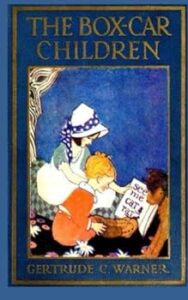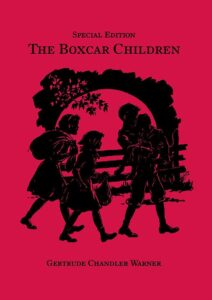


My title is taken from a song celebrated in the musical OLIVER. In typical Broadway fashion, Oliver Twist and the boys in the workhouse are dreaming of food…and though emaciated and probably starving, they have enough energy to dance around the stage, singing about FOOD. And if they were fed, it would not be foods they were dreaming about, but gruel, a very watery oatmeal, barely able to supply the calcium they needed for strong teeth and bones.
Yes, children suffer in Dickens’ novel, which was widely read by the British populace who were in many ways responsible for the huge gap between those that had and those that did not. But another way to look at this is that Dickens created Oliver Twist, a hero for a lifetime and well beyond.
Thus, I read with interest Anna Holmes recent piece in the New York Times: IT WAS ALWAYS ABOUT THE FOOD, her remembrance of reading THE BOXCAR CILDREN, a series of books by Gertrude Chandler Warner, that is celebrating its 100th year since publication.
The basic story line is not roses and lollipops, but I read every book in the series and like Anna Holmes, loved it, remembered it. Holmes writes in her intro: “Of course, in order to live in that boxcar you would have lost your parents (including a father who drank himself to death) and been on the run from “authorities” (concerned adults) who might want to separate you from your siblings or hand you over to your paternal grandfather—a man you heard was cruel.”
A great set-up, one that never bothered me, though by the time I was devouring these books my father had died, my mother was typing insurance policies at home to feed us: fresh eggs and cereal for breakfast; bakery bread sandwiches for lunch, plenty of fresh milk and various dinners that we hurried to the dining room to eat or lingered over now and again…what was that meat? But that’s normal for all kids!
It is also normal for children to be inspired in their creativity AFTER they have read good literature. Thus, my best friend and I tried to create a “house” at the end of her backyard that bordered the Rock Island Railroad tracks…and that backyard still does. We pulled weeds for hours, assuming they wouldn’t grow back. We racked the ground, created seating by piling stones. And food? Our mothers let us eat our sandwiches there, trains occasionally racing by, adding excitement to this place we had created.
In these wonderful books, The Boxcar Children created a home to survive. Anna Holmes writes: “At first, bread, butter, wild blueberries. Later, dried beef and ‘precious little vegetables’ like onions, carrots, potatoes and parsnips. Later still, ginger cookies, with scalloped edges, doughnuts and something called cherry slump. This was a meal ‘that nobody ever forgot.’”
Also in her piece, Holmes writes: “It was enough to make you wish you lived in a boxcar.” Well, maybe. As a child, reading about FOOD was fascinating, because what was being eaten was often different. Think: the Laura Ingalls Wilder Books. All of Louisa Mae Alcott’s books, Little Women, Little Men, the reader being introduced to a different time, place and foods.
Of course, literature does have the power to tidy things up a bit, if the author so chooses. Jane Smiley, famous for A Thousand Acres, wrote a novel about life in cabins in early times. She did not tidy things up, describing in detail how critters would find their way through the chinks in log cabins, so that when you woke up in the morning, your body heat was helping raccoons squirrels and other critters make it through the cold of night. Did the Boxcar Children deal with that? No, they had their boxcar and they had Warner’s kind imagination creating a place of wonderment…but not true reality. For children…THAT WORKS.
Warner’s ability to make food central to these books is so appealing to children, who are always looking for a snack, asking what’s for dinner…and writer Anna Holmes celebrates that in her piece. She also caused me and my husband to remember two of our many “food stories.”
The first: we are in Paris, sitting outside enjoying what only the Parisians truly know how to make, a croissant. It’s a beautiful warm day. Across the street a cab pulls up, a woman exits the cab, spends quite a few minutes yelling at the cabdriver, then goes into the building. Immediately, she appears on a balcony above and from there, leans over the grating, tossing coins down to the walkway below. This forces the driver to exist the cab and one by one collet his fair!
Then in Quebec, on our honeymoon, for the first time in our lives, we have lobster, a whole entire lobster with lots of butter…Food glorious food.
The Boxcar Children survived, found their grandfather…but it was always about the FOOD. Thanks for reading. Thanks to Anna Holmes Piece in the New York Times book section.

8 Responses
❤️
THANKS FOR THE HEART, THE LOVE, KAREN
That title, the “Boxcar Children” is familiar. I think I remember it as a child and loved it. I’ll have to check into it again. Thanks!
THANKS, LAURIE. As I mentioned, there was a piece in the NYT and it opened my memory. I loved those books and so did the author of the piece.
It was always about the food! Yes, children need to eat, love to eat. A joyous way to live, Beth
I never read the Boxcar Children books. I don’t remember the books from my childhood, either. Given that they are 100 years old I should – they would have been classics by the time I was born. Books certainly bring back memories. Now, I just might have to hunt these books down when I have a pause in my TBR list. Alana ramblinwitham
Thanks for your comment Alana. They were standard for years, along with Little Women and the Hardy Boys.
I read them all, and others at the behest of my mother. A good thing too, as she created the reader I still am to this day, Beth
I don’t remember these, myself. Wish I had read them back then, I was going through books at a wild clip!
Thanks, Carol. They do go back a while, but have been beloved my many, Beth